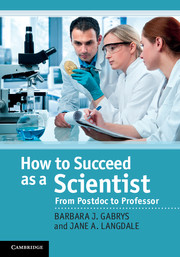Book contents
- Frontmatter
- Contents
- Preface
- Acknowledgements
- Part I Becoming an independent researcher
- Part II Thriving in your new job
- 10 Handling new roles
- 11 Learning from other people
- 12 Managing people
- 13 Building a research group I
- 14 Building a research group II
- 15 Interacting with others
- 16 Designing a taught course
- 17 Giving a good lecture
- 18 Beyond lecturing
- 19 Mentoring
- Part III Managing your career
- Index
- References
18 - Beyond lecturing
from Part II - Thriving in your new job
Published online by Cambridge University Press: 05 November 2011
- Frontmatter
- Contents
- Preface
- Acknowledgements
- Part I Becoming an independent researcher
- Part II Thriving in your new job
- 10 Handling new roles
- 11 Learning from other people
- 12 Managing people
- 13 Building a research group I
- 14 Building a research group II
- 15 Interacting with others
- 16 Designing a taught course
- 17 Giving a good lecture
- 18 Beyond lecturing
- 19 Mentoring
- Part III Managing your career
- Index
- References
Summary
In the sciences, lectures are complemented by classes, laboratory or fieldwork, seminars and different types of projects. All of these methods are meant to foster increasingly independent learning as well as provide a sound basis for being a proficient scientist. All of the methods have their merits and problems, but at the very least they should engage the student and have meaning and relevance to material given in lectures. In this chapter, we discuss small group teaching methods, inspect distance learning and give a brief overview of the possibilities offered by interactive teaching. The pedagogical principles expounded in the previous two chapters underpin this discussion. We finish by finding out what students have to say about teaching and learning.
The theory
Giving lectures is the mainstay of an academic profession – in the UK the most junior long-term or permanent position is ‘lecturer’. In Chapters 16 and 17 we discussed how to design, prepare and deliver lectures whereas in this chapter we turn our attention to other methods that can bring about effective learning. It is important to remember that a sound teaching strategy is more important than the delivery method (Ramsden, 2003). The assumption that a method, particularly a technologically advanced one, is the key to effective learning is false.
Small group teaching
Somewhat simplistically there is a basic difference between lecturing and teaching a small class: in the former the lecturer speaks ex cathedra and there is often a physical distance between the lecturer and the audience. If, in addition, there are 200 students or so, opportunities for interaction (asking questions, for example) are rather limited. Although it is not impossible, attempting to interact with a large audience is not for the shy as controlling the situation takes some experience. In class-based teaching, however, the lecturer is more approachable and even the room setting can encourage closer teacher–student interaction, and peer learning through work in small groups.
Information
- Type
- Chapter
- Information
- How to Succeed as a ScientistFrom Postdoc to Professor, pp. 162 - 168Publisher: Cambridge University PressPrint publication year: 2011
